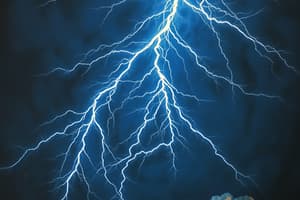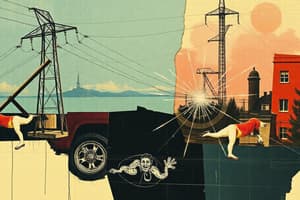Podcast
Questions and Answers
What happens when a neutral object is rubbed against another neutral object?
What happens when a neutral object is rubbed against another neutral object?
- Electrons are lost from both objects.
- Both objects become positively charged.
- Electrons are transferred, creating two charged surfaces. (correct)
- No charge is created.
Which statement is true about conductors?
Which statement is true about conductors?
- They always carry a negative charge.
- They allow electrons to move through them easily. (correct)
- They hold static charge.
- They prevent any movement of electrons.
What occurs during charging by induction?
What occurs during charging by induction?
- The neutral object becomes fully positively charged.
- A charged object touches a neutral object.
- The protons in the neutral object move to create charge.
- Electrons in the neutral object are rearranged without touching. (correct)
Which phenomenon is associated with a sudden transfer of charge that can create sparks?
Which phenomenon is associated with a sudden transfer of charge that can create sparks?
What is the result of grounding an object?
What is the result of grounding an object?
During the electrostatic series, which type of object will likely lose electrons?
During the electrostatic series, which type of object will likely lose electrons?
What does charging by conduction specifically involve?
What does charging by conduction specifically involve?
How do oppositely charged objects interact?
How do oppositely charged objects interact?
Flashcards
What is static electricity?
What is static electricity?
The buildup of electrical charges on the surface of an object due to the transfer of electrons.
What is a conductor?
What is a conductor?
Materials that allow electrons to flow easily through them.
What is an insulator?
What is an insulator?
Materials that resist the flow of electrons.
What is the Law of Electric Charge?
What is the Law of Electric Charge?
Signup and view all the flashcards
What is charging by friction?
What is charging by friction?
Signup and view all the flashcards
What is charging by conduction (contact)?
What is charging by conduction (contact)?
Signup and view all the flashcards
What is charging by induction?
What is charging by induction?
Signup and view all the flashcards
What is an electric discharge?
What is an electric discharge?
Signup and view all the flashcards
Study Notes
Static Electricity
- Static electricity is the build-up of an electrical charge on an object.
- It occurs when atoms gain or lose electrons.
- Gaining electrons creates a negative charge.
- Losing electrons creates a positive charge.
- A spark happens when a charged object releases electrons to become neutral.
Conductors and Insulators
- Conductors allow electrons to move freely through them.
- Examples include metals.
- Insulators restrict electron movement, preventing static charge buildup.
- Examples include plastics and rubber.
Law of Electric Charge
- Opposites charges attract each other.
- Like charges repel each other.
- Charged objects attract neutral objects.
Charging by Friction
- Rubbing two neutral objects together transfers electrons.
- One object gains electrons (negative charge) and the other loses electrons (positive charge).
- Example: Rubbing a balloon against hair transfers electrons from hair to balloon.
Electrostatic Series
- A list of materials ranked based on their tendency to gain or lose electrons when rubbed against each other.
- Higher on the list loses electrons (positive charge).
- Lower on the list gains electrons (negative charge).
Charging by Conduction
- Transferring charge by direct contact.
- A charged object touching a neutral object transfers charge.
- Both objects end up with the same charge.
Charging by Induction
- Transferring charge without direct contact.
- A charged object is brought close to a neutral object.
- This causes charges in the neutral object to rearrange, creating a charge separation.
- The charges of the neutral objects rearrange without touching, building up opposite charges.
Grounding
- Connecting an object to the earth to neutralize a charge.
- Allows excess electrons to flow into the earth, causing a neutral charge.
Lightning
- Lightning is a large electrical discharge during a storm.
- Ice crystals in clouds rub together creating charge separation.
- Negative charges accumulate at the bottom of the cloud.
- Positive charges accumulate at the top of the cloud.
- Lightning occurs as a discharge of excess charge from the cloud to the ground (or another cloud).
Studying That Suits You
Use AI to generate personalized quizzes and flashcards to suit your learning preferences.



